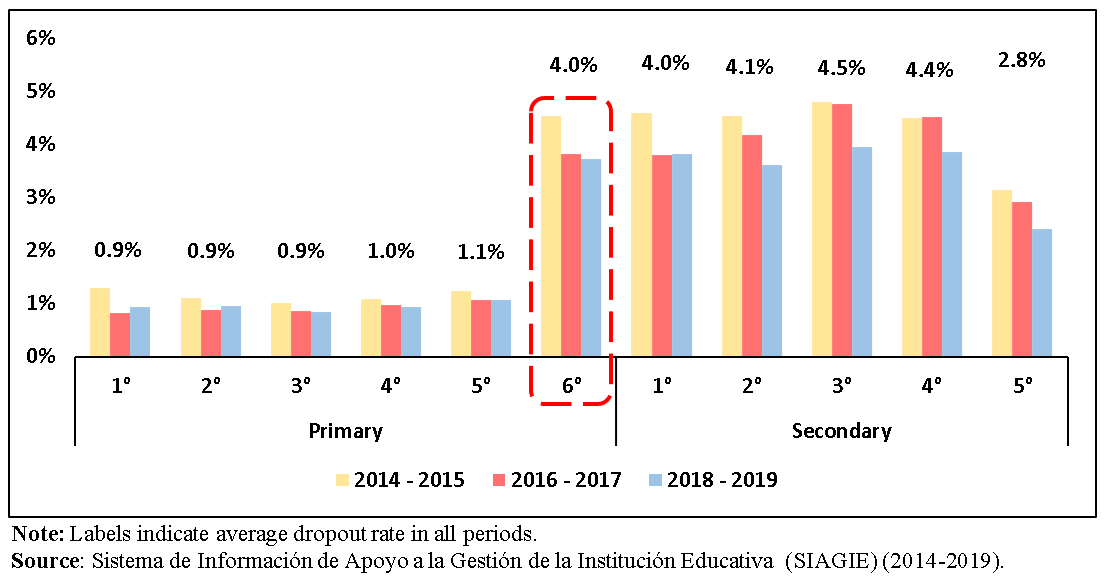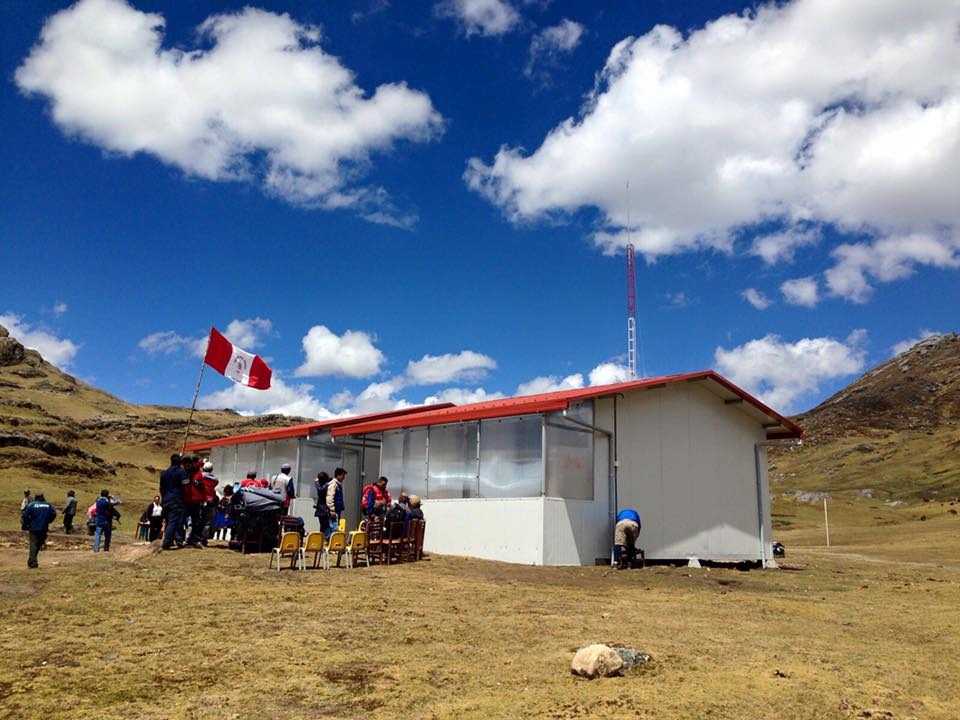Over the last 50 years, schooling expanded dramatically in most low- and middle-income countries, however, some disparities still remain, and have even been exacerbated by the Covid-19 pandemic. In Peru, even though in 2019, 97% of children between 6 and 11 years old had access to primary education, 13% of youngsters between 12 and 16 years old did not have access to secondary education1. If we consider dropout rates at this level, youngsters in rural areas are 2 percentage points (pp.) more likely to drop out of school than in urban areas. While the issue of school dropout could be explained by the opportunity cost to continuing with schooling, this is also explained through policies on the supply side: in rural areas hold 60% of primary schools nationwide, but only 30% of secondary schools are there, which is not sufficient to cover the student population. In other words, this means that there is no transition between primary and secondary schools given the dispersion of school infrastructure.
Between 2018 and 2019, more than 90 thousand students left secondary school -a national dropout rate of 3.5%2. Dropout rates showed a “jump” in the completion of primary education, meaning that a considerable group of students does not transition to secondary education (see Figure 1). This issue is even more problematic in rural areas, where the difference with urban areas could be as high as 10 pp. Alcazar (2008) suggests that it is due to supply availability (i.e amount of physical infrastructure) is very limited in these areas3. In this line, other studies mention that the distance between home and school is one of the main determinants of school dropout4.
Figure 1. Dropout rate by grade

To analyze whether land connectivity between primary and secondary schools in rural areas contributes to drop out during the transition between these levels, we proposed using administrative and geospatial data from the Ministry of Education of Peru to calculate distances between schools and dropout rates. To this end, we used a family-level fixed effects estimator that exploits the variation in the availability of secondary schools around primary schools where the siblings of each family in the sample graduate. Additionally, we define connectivity through time distances between schools. For example, a primary school is connected to a secondary school if there are one or more secondary schools within an “x” minutes radius around it (see Figure 2).
Figure 2. Connectivity definition

Results show that students who graduate from primary schools that are not connected to a secondary school are one-third more likely not to transition. This, even controlling for student and school characteristics. Thus, the wide geographic dispersion of secondary schools makes access more costly in terms of transportation time or school searching5.
In this context, it is relevant to develop or promote policies that improve connectivity between primary and secondary schools.
First, although the construction of secondary schools may be the most common policy recommendation, its feasibility entails high costs. In 2017, the estimated infrastructure gap in Peru was equivalent to 10% of the country’s GDP, and at the rate of infrastructure spending at the time, it would have taken 30 years to close the gap6. Thus, a policy of territorial reordering of educational services could be more effective in the medium term, if it focuses on providing a clean transition throughout school levels. While integrated schools (those that provide services at primary and secondary level) show a dropout rate of 1%, non-integrated schools show a dropout rate of around 5%. Thus, through the creation of institutions that integrate educational levels and greater autonomy of educational centers, the transition between primary and secondary education could be improved7.
Second, connecting schools also implies investing in transportation systems that respond directly to the educational system. Our study shows that connectivity issues are mainly focused on semi-urban areas. Thus, georeferenced information from schools could be used to evaluate transportation routes and the design of a system in which primary schools work as “satelites” for secondary schools that act as “hubs”. In this way, families would still have to bear the cost of going to the primary schools, while the government would be responsible for taking children from the primary schools to the nearest secondary schools.
Third, considering areas with higher rurality, an alternative is the expansion of strategies such as the Diversified Attention Forms (FAD for its acronym in Spanish) provided by the Ministry of Education. These strategies allow children in rural areas to have access to quality education according to their specific context8. One of these strategies is Secundarias Tutoriales (Tutoring secondary schools), in which blended education (i.e in-person and remote) is provided to students who are more than 75 minutes walking distance from a school. Another strategy is expanding Residential High Schools, that act as boarding schools where students live. While these strategies are used for children whose location exceeds the distances assessed in our study, making distances more flexible should be considered in order to increase access to secondary education.
Finally, in cases where student mobility is not possible, an alternative could be using hybrid education models. In this way, it is possible to use resources provided by strategies such as Cierre de Brechas Digitales (where tablets are given to students and teachers) or Aprendo en Casa (a distance education multiplatform) to “bring” secondary education to student’s homes. International evidence suggests that similar strategies were successful closing gaps in access to education and long-term returns9. Although hybrid education has been well exploited in some contexts, it should be considered an alternative option only if presential education is not available. This is due to the existence of evidence showing that distance education can be detrimental to learning10 and the lower access to technology in rural areas11.
References:
[1] Instituto Nacional de Estadística e Informática (2019). Encuesta Nacional de Hogares. Lima. Accessed at: http://iinei.inei.gob.pe/microdatos/
[2] Ministry of Education of Peru (2022). Estadística de la Calidad Educativa (ESCALE). Lima. Accessed at: http://escale.minedu.gob.pe/
[3] Alcázar, L. (2008). Asistencia y deserción en escuelas secundarias rurales del Perú. In M. Benavides (ed.), Análisis de programas, procesos y resultados educativos en el Perú: contribuciones empíricas para el debate (pag. 41-82). Lima: GRADE.
[4] Henki, Z., Nismawati, & Lamadirisi, M. (2020). School Dropout (Case Study of Farmers Children in Tounsaru District of South Tondano Minahasa Regency). Advances in Social Science, Education and Humanities Research, 473: 73-78.
[4] Hussain, A., Salfi, N. A., & Khan, T. M. (2011). Causes of Students’ Dropout at Primary Level in Pakistan: An Empirical Study. International Journal of Humanities and Social Science, 1(12): 143-151.
[4] Rolleston, C., Akyeampong, K., Ampiah, J. G., & Lewin, K. M. (2010). Educational Access in Ghana. Country Research Summary. Consortium for Educational Access, Transitions and Equity.
[5] Gutiérrez, J. (2022). ¿Mayor conectividad entre escuelas reduce la deserción escolar? Un análisis geoespacial en la transición educativa primaria – secundaria en el Perú. Lima: Universidad del Pacífico. Accessed at: https://hdl.handle.net/11354/3393
[6] Ministry of Education of Peru (2017). Plan Nacional de Infraestructura Educativa al 2025. Accessed at: http://repositorio.minedu.gob.pe/handle/20.500.12799/5952
[7] Guadalupe, C., & Rivera, A. (2020). Cómo crear centros educativos integrados de Educación Básica Regular. Lima: Universidad del Pacífico.
[8] Guerrero, G. (2018). Evaluación del diseño e implementación de las formas de atención diversificada en el nivel de educación secundaria de la educación básica regular en el ámbito rural (FAD). Lima: GRADE.
[9] Navarro-Sola, L. (2019). Secondary School Expansion through Televised Lessons: The Labor Market Returns of the Mexican Telesecundaria. Working Paper.
[10] Alpert, W., Couch, K., & Harmon, O. (2016). A Randomized Assessment of Online Learning. American Economic Review, 106(5), 378–382.
[10] Bettinger, E. P., Fox, L., Loeb, S., & Taylor, E. S. (2017). Virtual Classrooms: How Online College Courses Affect Student Success. American Economic Review, 107(9), 2855–2875.
[10] Cacault, M. P., Hildebrand, C., Laurent-Lucchetti, J., & Pellizzari, M. (2021). Distance Learning in Higher Education: Evidence from a Randomized Experiment. Journal of the European Economic Association.
[10] Figlio, D., Rush, M., & Yin, L. (2013). Is It Live or Is It Internet? Experimental Estimates of the Effects of Online Instruction on Student Learning. Journal of Labor Economics, 31(4), 763–784.
[11] Instituto Nacional de Estadística e Informática. (2020). Estadísticas de las tecnologías de la información en los hogares. Informe técnico 2. Accessed at https://www.inei.gob.pe/media/MenuRecursivo/boletines/boletin_tics.pdf
